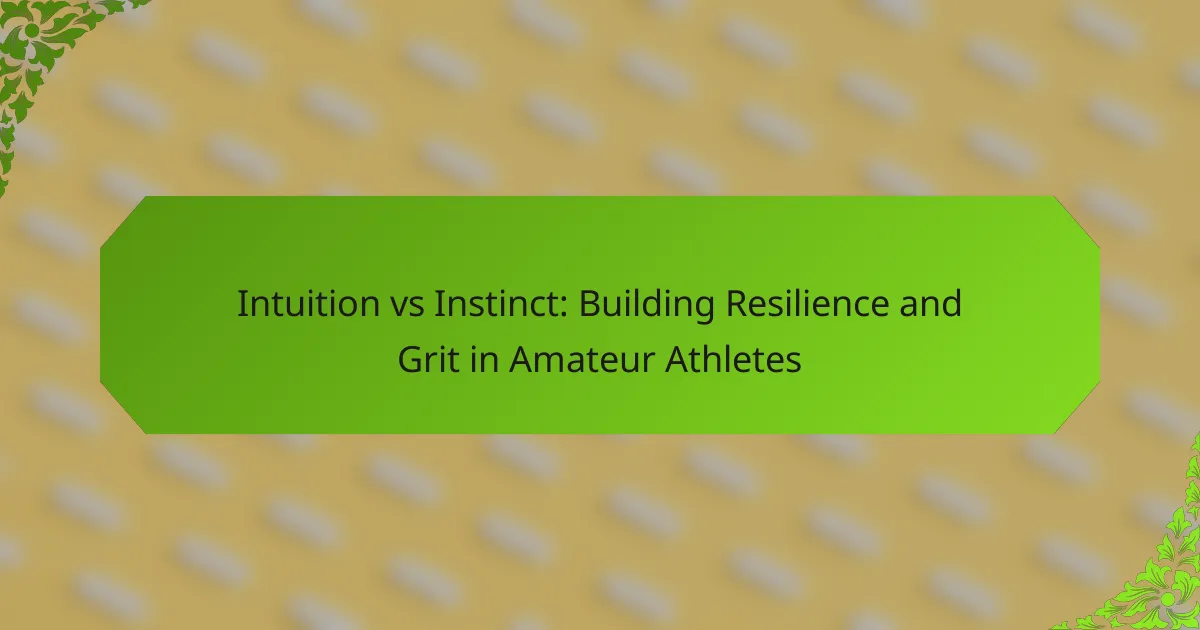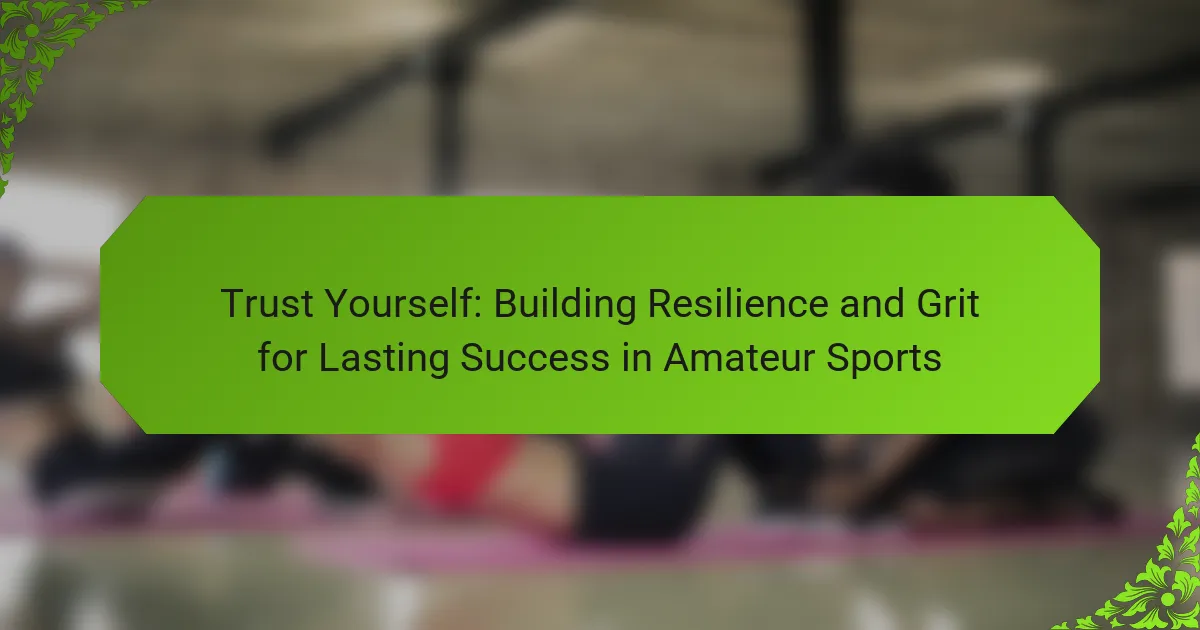Cultivating resilience and grit is essential for amateur athletes facing unpredictable training environments. Organized chaos in training promotes adaptability and mental toughness. This approach encourages varied intensity, unconventional goals, and reflective practices. Expert insights on mental training further enhance athletes’ ability to thrive under pressure.

What is Organized Chaos in Training for Amateur Athletes?
Organized chaos in training for amateur athletes refers to a structured yet flexible approach that fosters resilience and grit. This method emphasizes adaptability in training regimens, allowing athletes to thrive under unpredictable conditions. By incorporating varied training environments and challenges, athletes develop problem-solving skills and mental toughness. This approach enhances performance, as athletes learn to cope with stress and uncertainty, ultimately leading to improved outcomes in competitions.
How does Organized Chaos contribute to Resilience and Grit?
Organized Chaos fosters resilience and grit by encouraging adaptability in amateur athletes. It incorporates unpredictable training elements that challenge athletes to think critically and respond effectively under pressure. This dynamic environment builds mental toughness, enhancing their ability to overcome adversity. As a result, athletes develop a robust mindset, crucial for long-term success in sports.
What are the key components of Organized Chaos?
Organized Chaos in training emphasizes adaptability, creativity, and resilience in amateur athletes. Key components include structured unpredictability, diverse training modalities, and mental fortitude development. These elements foster grit and enhance performance under pressure, preparing athletes for real-world challenges.
How can flexibility in training schedules enhance performance?
Flexibility in training schedules enhances performance by allowing athletes to adapt their routines based on recovery needs and personal circumstances. This adaptability fosters resilience and grit, essential qualities for amateur athletes. When training is organized yet fluid, athletes can optimize their physical and mental resources. Research indicates that varied training environments improve problem-solving skills and increase motivation, resulting in better overall performance. Emphasizing a balance between structure and spontaneity cultivates a robust mindset, enabling athletes to face challenges effectively.
What role does unpredictability play in skill development?
Unpredictability is crucial in skill development as it fosters resilience and grit in amateur athletes. Exposure to varying challenges enhances adaptability, enabling athletes to navigate unexpected situations effectively. This dynamic training environment cultivates mental toughness, which is essential for long-term success. Engaging with unpredictability also encourages problem-solving skills, as athletes learn to adjust their strategies in real-time.
What are the Universal Benefits of Resilience and Grit?
Resilience and grit provide amateur athletes with improved mental toughness, adaptability, and sustained motivation. These traits enhance performance by enabling athletes to overcome setbacks and maintain focus during training. Research indicates that athletes with high resilience show better recovery rates and longer commitment to their training regimes. Grit, characterized by perseverance and passion, correlates with higher achievement levels in sports. Together, these qualities foster a growth mindset, essential for continuous improvement and success in athletic endeavors.
How do these traits improve performance under pressure?
Organized chaos enhances performance under pressure by fostering adaptability and quick decision-making. Athletes develop resilience through exposure to unpredictable training environments, which simulates competitive stress. This approach cultivates grit, enabling them to push through challenges and maintain focus. As a result, their mental fortitude improves, leading to better performance in high-pressure situations.
What impact do they have on mental health and well-being?
Organized chaos positively impacts mental health and well-being by fostering resilience and grit in amateur athletes. This approach promotes adaptability, enabling athletes to manage stress effectively. Studies show that training in unpredictable environments enhances problem-solving skills and emotional regulation. Additionally, engaging in such training can lead to increased motivation and a sense of accomplishment, which are crucial for overall mental well-being.
What Unique Strategies can Amateur Athletes adopt?
Amateur athletes can adopt unique strategies like embracing structured unpredictability, fostering mental toughness, and prioritizing adaptability. These approaches cultivate resilience and grit, essential for overcoming challenges in training.
Structured unpredictability involves varying training routines to simulate competition pressure, enhancing adaptability. Mental toughness can be developed through visualization techniques, helping athletes manage stress. Prioritizing recovery and self-reflection further strengthens resilience, allowing athletes to learn from setbacks.
How can goal-setting foster grit?
Goal-setting fosters grit by providing structure and motivation in training. Clear, achievable goals help amateur athletes focus their efforts, enhancing resilience through consistent progress. This process encourages a growth mindset, enabling athletes to embrace challenges and learn from setbacks. As they experience success in reaching their goals, their confidence and determination strengthen, reinforcing their grit over time.
What specific training techniques build resilience?
Structured training techniques that build resilience include progressive overload, mental conditioning, and varied training environments. Progressive overload gradually increases intensity, promoting adaptation and grit. Mental conditioning focuses on visualization and positive self-talk, enhancing mental toughness. Varied training environments expose athletes to unpredictable conditions, fostering adaptability and resilience.
What Rare Practices enhance Resilience and Grit?
Engaging in rare practices such as unconventional training methods and mindfulness techniques enhances resilience and grit in amateur athletes. These practices foster adaptability, mental toughness, and emotional regulation, which are crucial for overcoming challenges. For example, incorporating obstacle courses or unpredictable training environments can simulate competition stress, encouraging athletes to develop coping strategies. Additionally, mindfulness exercises improve focus and reduce anxiety, further strengthening mental resilience.
How can journaling experiences shape an athlete’s mindset?
Journaling experiences can significantly enhance an athlete’s mindset by promoting self-reflection and emotional processing. This practice cultivates resilience and grit, essential attributes for amateur athletes facing training challenges.
Through journaling, athletes can document their thoughts, feelings, and performance, leading to increased self-awareness. This unique attribute helps them identify patterns in their training and competition experiences. As a result, athletes develop coping strategies to manage stress and setbacks, enhancing their mental toughness.
Research indicates that athletes who engage in reflective writing show improved focus and motivation. By consistently recording their journeys, they build a narrative of growth that reinforces their commitment to training. This organized chaos of thoughts ultimately shapes a more resilient mindset, enabling them to navigate the ups and downs of their athletic pursuits.
What unconventional methods have proven effective?
Unconventional methods such as incorporating play and unpredictability into training have proven effective in cultivating resilience and grit in amateur athletes. These approaches challenge athletes to adapt to varying conditions, fostering mental toughness and problem-solving skills. For example, obstacle courses and improvisational drills encourage athletes to think creatively under pressure. Additionally, integrating mindfulness practices can enhance focus and emotional regulation, further supporting resilience development.

How can Amateur Athletes implement Organized Chaos in their training?
Amateur athletes can implement Organized Chaos by incorporating varied and unpredictable training elements. This approach enhances resilience and grit, pushing athletes beyond their comfort zones.
To apply Organized Chaos, athletes can include exercises with varying intensity, unexpected challenges, and diverse training environments. For example, integrating interval training with random rest periods forces adaptation.
Additionally, athletes should embrace mental flexibility by setting unconventional goals, such as mastering new skills or engaging in cross-training activities. This promotes a growth mindset and prepares them for competition unpredictability.
Finally, tracking progress through reflective practices helps athletes assess their resilience development. Regularly reviewing challenges faced and strategies employed fosters a deeper understanding of personal growth.
What are practical steps to create a chaotic training environment?
To create a chaotic training environment that fosters resilience and grit in amateur athletes, implement varied and unpredictable training scenarios. Incorporate diverse drills, unexpected challenges, and time constraints to simulate real-world pressures.
1. Vary training locations to introduce new stimuli.
2. Mix skill levels within training groups to enhance adaptability.
3. Introduce random elements, such as surprise competitions, to develop mental toughness.
4. Encourage athletes to set personal goals that push their limits.
5. Provide feedback that focuses on effort and progress rather than just outcomes.
How can athletes incorporate varied training stimuli?
Athletes can incorporate varied training stimuli by diversifying their workouts. This approach enhances resilience and grit in amateur athletes.
1. Mix different training modalities, such as strength, endurance, and flexibility exercises.
2. Implement interval training to introduce intensity variations.
3. Utilize unconventional equipment like kettlebells, resistance bands, or medicine balls.
4. Engage in outdoor activities to adapt to changing environments.
5. Schedule recovery days with active rest to promote adaptation.
6. Experiment with different training locations to stimulate mental engagement.
What role does peer feedback play in this process?
Peer feedback fosters growth in amateur athletes by enhancing resilience and grit. It provides constructive insights that help athletes identify strengths and areas for improvement. This collaborative process encourages a supportive environment, enabling athletes to face challenges with confidence. As a result, peer feedback cultivates a culture of persistence, essential for success in training.
What common mistakes should be avoided when cultivating Resilience and Grit?
To cultivate resilience and grit effectively, avoid common mistakes such as setting unrealistic expectations, neglecting recovery, and failing to embrace discomfort. Unrealistic expectations can lead to frustration and burnout. Neglecting recovery hinders progress and increases injury risk. Embracing discomfort is essential for growth; avoiding challenges limits development.

What Expert Insights can enhance Resilience and Grit development?
Expert insights can significantly enhance resilience and grit development in amateur athletes by focusing on mental training, adaptability, and structured feedback. Mental training techniques, such as visualization and mindfulness, improve focus and emotional regulation. Adaptability is essential; athletes should embrace challenges as opportunities for growth. Structured feedback from coaches fosters a growth mindset, helping athletes learn from failures and successes. These elements collectively cultivate a robust training environment that nurtures resilience and grit.
What best practices should Amateur Athletes follow?
Amateur athletes should prioritize consistency, adaptability, and mental toughness in their training. Establish a structured routine that incorporates varied training methods to build resilience. Focus on goal-setting, self-reflection, and recovery strategies to enhance grit and performance. Embrace challenges as opportunities for growth, fostering a mindset that thrives in uncertain conditions.
How can athletes measure their progress in building these traits?
Athletes can measure their progress in building resilience and grit through consistent self-assessment and performance metrics. Tracking improvements in training intensity, recovery times, and mental toughness exercises provides quantifiable data. Regularly reflecting on challenges faced and overcome enhances self-awareness. Utilizing feedback from coaches and peers also supports progress evaluation.
What resources are available for further learning?
Various resources are available for further learning about cultivating resilience and grit in amateur athletes’ training. Books such as “Grit: The Power of Passion and Perseverance” by Angela Duckworth provide insights into developing mental toughness. Online courses on platforms like Coursera and Udemy offer structured training modules focused on resilience-building techniques. Additionally, podcasts featuring sports psychologists discuss practical strategies for enhancing grit. Research articles in sports psychology journals present empirical studies on athlete resilience. Lastly, community workshops and seminars often provide hands-on experiences and peer support for athletes.



